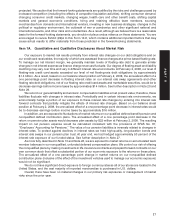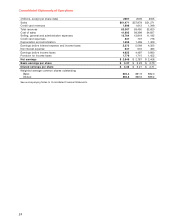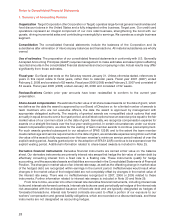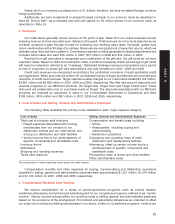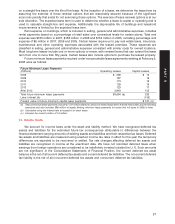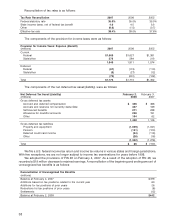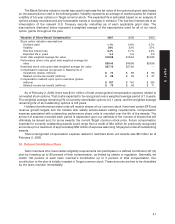Target 2007 Annual Report Download - page 49
Download and view the complete annual report
Please find page 49 of the 2007 Target annual report below. You can navigate through the pages in the report by either clicking on the pages listed below, or by using the keyword search tool below to find specific information within the annual report.
8. Cash Equivalents
Cash equivalents include highly liquid investments with an original maturity of three months or less from
the time of purchase. We carry these investments at cost, which approximates market value. These
investments were $1,851 million and $281 million at February 2, 2008 and February 3, 2007, respectively. Also
included in cash equivalents are proceeds due from credit and debit card transactions with settlement terms
of less than five days. Credit and debit card receivables included within cash equivalents were $367 million
and $355 million at February 2, 2008 and February 3, 2007, respectively.
9. Accounts Receivable
Accounts receivable are recorded net of an allowance for expected losses. The allowance, recognized in
an amount equal to the anticipated future write-offs, was $570 million at February 2, 2008 and $517 million at
February 3, 2007. We estimate future write-offs based on delinquencies, risk scores, aging trends, industry
risk trends and our historical experience. Substantially all accounts continue to accrue finance charges until
they are written off. Total accounts receivable past due ninety days or more and still accruing finance charges
were $235 million at February 2, 2008 and $160 million at February 3, 2007. Accounts are written off when they
become 180 days past due.
As a method of providing funding for our accounts receivable, we sell on an ongoing basis all of our
consumer credit card receivables to Target Receivables Corporation (TRC), a wholly owned, bankruptcy-
remote subsidiary. TRC then transfers the receivables to the Target Credit Card Master Trust (the Trust), which
from time to time will sell debt securities to third parties either directly or through a related trust. These debt
securities represent undivided interests in the Trust assets. TRC uses the proceeds from the sale of debt
securities and its share of collections on the receivables to pay the purchase price of the receivables to Target.
The accounting guidance for such transactions, SFAS No. 140, ‘‘Accounting for Transfers and Servicing
of Financial Assets and Extinguishments of Liabilities (a replacement of SFAS No. 125),’’ requires the inclusion
of the receivables within the Trust and any debt securities issued by the Trust, or a related trust, in our
Consolidated Statements of Financial Position. Notwithstanding this accounting treatment, the receivables
transferred to the Trust are not available to general creditors of Target. Upon termination of the securitization
program and repayment of all debt securities issued from time to time by the Trust, or a related trust, any
remaining assets could be distributed to Target in a liquidation of TRC.
10. Inventory
Substantially all of our inventory and the related cost of sales are accounted for under the retail inventory
accounting method (RIM) using the last-in, first-out (LIFO) method. Inventory is stated at the lower of LIFO cost
or market. Cost includes purchase price as adjusted for vendor income. Inventory is also reduced for
estimated losses related to shrink and markdowns. The LIFO provision is calculated based on inventory
levels, markup rates and internally measured retail price indices. At February 2, 2008 and February 3, 2007,
our inventories valued at LIFO approximate those inventories as if they were valued at FIFO.
Under RIM, the valuation of inventory at cost and the resulting gross margins are calculated by applying a
cost-to-retail ratio to the retail value inventory. RIM is an averaging method that has been widely used in the
retail industry due to its practicality. The use of RIM will result in inventory being valued at the lower of cost or
market since permanent markdowns are currently taken as a reduction of the retail value of inventory.
We routinely enter into arrangements with certain vendors whereby we do not purchase or pay for
merchandise until the merchandise is ultimately sold to a guest. Revenues under this program are included in
sales in the Consolidated Statements of Operations, but the merchandise received under the program is not
included in inventory in our Consolidated Statements of Financial Position because of the virtually
simultaneous timing of our purchase and sale of this inventory. Sales made under these arrangements totaled
$1,390 million, $1,178 million and $872 million for 2007, 2006 and 2005, respectively.
31
PART II


